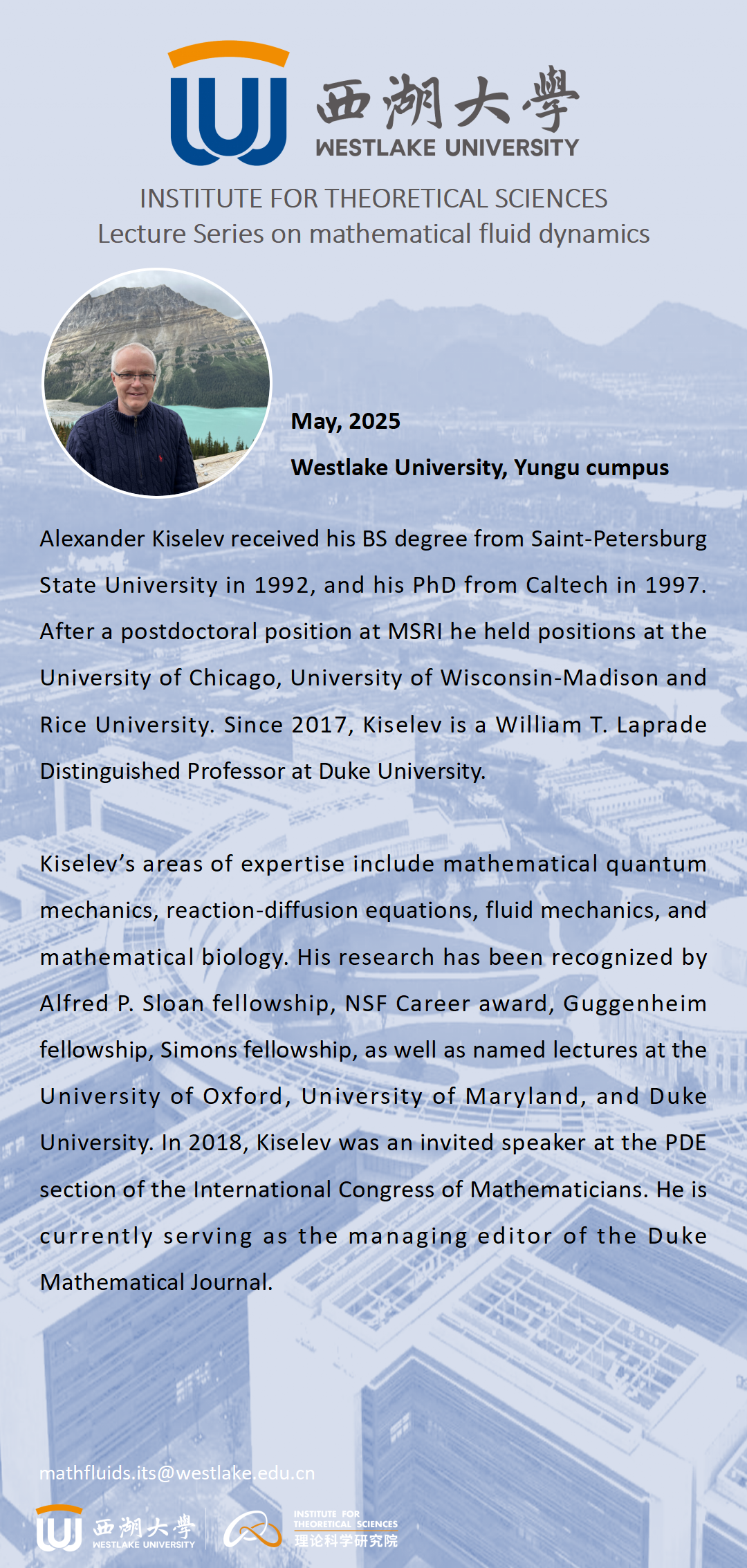Time: May 30 - June 1, 2025
Venue: E4-233, Yungu Campus
Zoom ID: 946 8893 9106
Passcode: 715681
Speaker: Alexander Kiselev, Duke Univeristy
Title: Regularity and small scale creation in equations of fluid mechanics
Abstract: I will discuss several recent themes on regularity and small scale creation in equations of fluid mechanics and related PDE. I will start with an overview of the field and then present some recent results on small scale generation and potential singularity formation. A subtle nature of these processes in incompressible fluids is that fluid advection can also act as a regularization mechanism, that I will illustrate with recent results on global regularity of the Patlak-Keller-Segel equation coupled with active scalar by buoyancy. If time permits, I may also discuss a surprising connection between fluid mechanics and a classical question of evolution of polynomial roots under differentiation.
1st Lecture 9:00-10:00, Friday, May 30 2025
Title: Small scale creation in equations of fluid mechanics
Abstract: Most of the fundamental equations of fluid mechanics are nonlinear and nonlocal. Some of the key examples are the Euler equation for ideal fluid, the surface quasi-geostrophic (SQG) equation coming from atmospheric science, the Boussinesq system modeling buoyant fluid, and the incompressible porous media (IPM) equation. Solutions to these equations are often prone to instabilities, small scale creation and possibly singularity formation. I will overview some of the recent results on small scale creation in solutions of fluid mechanics, with the focus on recent works on the porous media equation and Boussinesq system joint with Benjamin Park and Yao Yao.
2nd Lecture 9:00-10:00, Saturday, May 31 2025
Title: Suppression of chemotactic blow up by buoyancy
Abstract: There exist many regularization mechanisms in nonlinear PDE that help make solutions more regular or prevent formation of singularity: diffusion, dispersion, damping. A relatively less understood regularization mechanism is transport. There is evidence that in the fundamental PDE of fluid mechanics such as Euler or Navier-Stokes, transport can play a regularizing role. In this talk, I will discuss another instance where this phenomenon appears: the Patlak-Keler-Segel equation of chemotaxis. Chemotactic blow up in the context of the Patlak-Keller-Segel equation is an extensively studied phenomenon. In recent years, it has been shown that the presence of a given fluid advection can arrest singularity formation given that the fluid flow possesses mixing or diffusion enhancing properties and its amplitude is sufficiently strong. This talk will focus on the case when the fluid advection is active: the Patlak-Keller-Segel equation coupled with fluid that obeys Darcy's law for incompressible porous media flow via gravity. Surprisingly, in this context, in contrast with the passive advection, active fluid is capable of suppressing chemotactic blow up at arbitrary small coupling strength: namely, the system always has globally regular solutions. The talk is based on works joint with Zhongtian Hu, Naji Sarsam, and Yao Yao.
3rd Lecture 15:30-16:30, Saturday, May 31 2025
Title: Regularity of vortex and SQG patches
Abstract: Patch solutions are an important class of special singular solutions to the 2D Euler or surface quasi-geostrophic (SQG) equations that model evolution of regions of vorticity with sharp boundaries (like hurricanes) or sharp temperature fronts in atmosphere. I will discuss recent progress on regularity properties of vortex and SQG patches. In particular, I will present an example of a vortex patch with continuous initial curvature that immediately becomes infinite but returns to C^2 class at all integer times only without being time periodic. The proof involves derivation of a new system describing the patch evolution in terms of arc-length and curvature. A similar approach leads to discovery of strong ill-posedness of the SQG patches in all but L^2 based spaces, or spaces of infinitely smooth functions. The talk is based on a work joint with Xiaoyutao Luo.
4th Lecture 9:00-10:00, Sunday, June 1 2025
Title: The flow of polynomial roots under differentiation
Abstract: The question of how polynomial roots move under differentiation is classical. Contributions to this subject have been made by Gauss, Lucas, Marcel Riesz, Polya and many others. In 2018, Stefan Steinerberger derived formally a PDE that should describe the dynamics of polynomial roots under differentiation in certain situations. The PDE in question is of hydrodynamic type and bears a striking resemblance to the models used in mathematical biology to describe collective behavior and flocking of various species - such as fish, birds or ants. I will discuss joint work with Changhui Tan in which we establish global regularity of Steinerberger's equation and make a rigorous connection between its solutions and evolution of roots under differentiation for a class of trigonometric polynomials.
Click for more Analysis and Applied Math seminar talk

